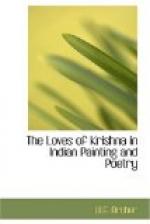of God was the one most valid. God must be adored.
Krishna himself was God and since he had shown divine
love in passionately possessing the cowgirls, he was
best adored by recalling these very encounters.
As a result, Krishna’s relations with the cowgirls
were now enormously magnified and as part of this fresh
appraisal, a particular married cowgirl, Radha, enters
the story as the enchanting object of his passions.
We have seen how on one occasion in the
Bhagavata
Purana, Krishna disappears taking with him a single
girl, how they then make love together in a forest
bower and how when the girl tires and begs Krishna
to carry her, he abruptly leaves her. The girl’s
name is not mentioned but enough is said to suggest
that she is Krishna’s favourite. This hint
is now developed. Radha, for this is the girl’s
name, is recognized as the loveliest of all the cowgirls.
She is the daughter of the cowherd Vrishabhanu and
his wife, Kamalavati, and is married to Ayana, a brother
of Yasoda. Like other cowgirls, her love for Krishna
is all-consuming and compels her to ignore her family
honour and disregard her husband. Krishna, for
his part, regards her as his first love. In place,
therefore, of courtly adventures and battles with demons,
Krishna’s adulterous romance is now presented
as all in all.[47] It is the moods, feelings and emotions
of a great love-affair which are the essence of the
story and this, in turn, is to serve as a sublime allegory
expressing and affirming the love of God for the soul.
With this dramatic revolution in the story, we begin
to approach the Krishna of Indian painting.
Such a change can hardly have come about without historical
reasons and although the exact circumstances must
perhaps remain obscure, we can see in this sharp reversal
of roles a clear response to certain Indian needs.
From early times, romantic love had been keenly valued,
Sanskrit poets such as Kalidasa, Amaru and Bhartrihari
celebrating the charms of womanly physique and the
raptures of sex. What, in fact, in other cultures
had been viewed with suspicion or disquiet was here
invested with nobility and grandeur. Although
fidelity had been demanded in marriage, romantic liaisons
had not been entirely excluded and thus there was a
sense in which the love-poetry of the early Indian
middle ages had been partly paralleled by actual courtly
or village practice. From the tenth century onwards,
however, a tightening of domestic morals had set in,
a tightening which was further intensified by the
Muslim invasions of the twelfth and thirteen centuries.
Romance as an actual experience became more difficult
of attainment and this was exacerbated by standard
views of marriage. In early India, marriage had
been regarded as a contract between families and romantic
love between husband and wife as an accidental, even
an unexpected product of what was basically a utilitarian
agreement. With the seclusion of women and the
laying of even greater stress on wifely chastity,




